China's Ascent: Global Commercial Leader and Economic Superpower
VerifiedAdded on 2022/11/09
|66
|13309
|262
Report
AI Summary
This report comprehensively investigates the factors contributing to China's rise as a global commercial leader and its increasing influence on the global economy. The study delves into the historical background, including the impact of economic reforms, investment in technology and education, labor mobility, foreign direct investment, and government policies. It examines key economic indicators such as GDP, trade, and investment trends. The research employs a mixed-methods approach, combining qualitative analysis with statistical tools to establish relationships between various economic factors. The report includes an introduction, literature review, research methodology, data analysis, and conclusions, offering insights into China's economic transformation and its implications for the global market. The analysis also includes a comparison with the United States, highlighting the characteristics and strategies that have enabled China's ascent. The paper uses statistical tools to establish the key findings of the paper in relation with correlation coefficient, sampling, Balance of Payments and interpret the sectorial growth of China and US in the coming years.
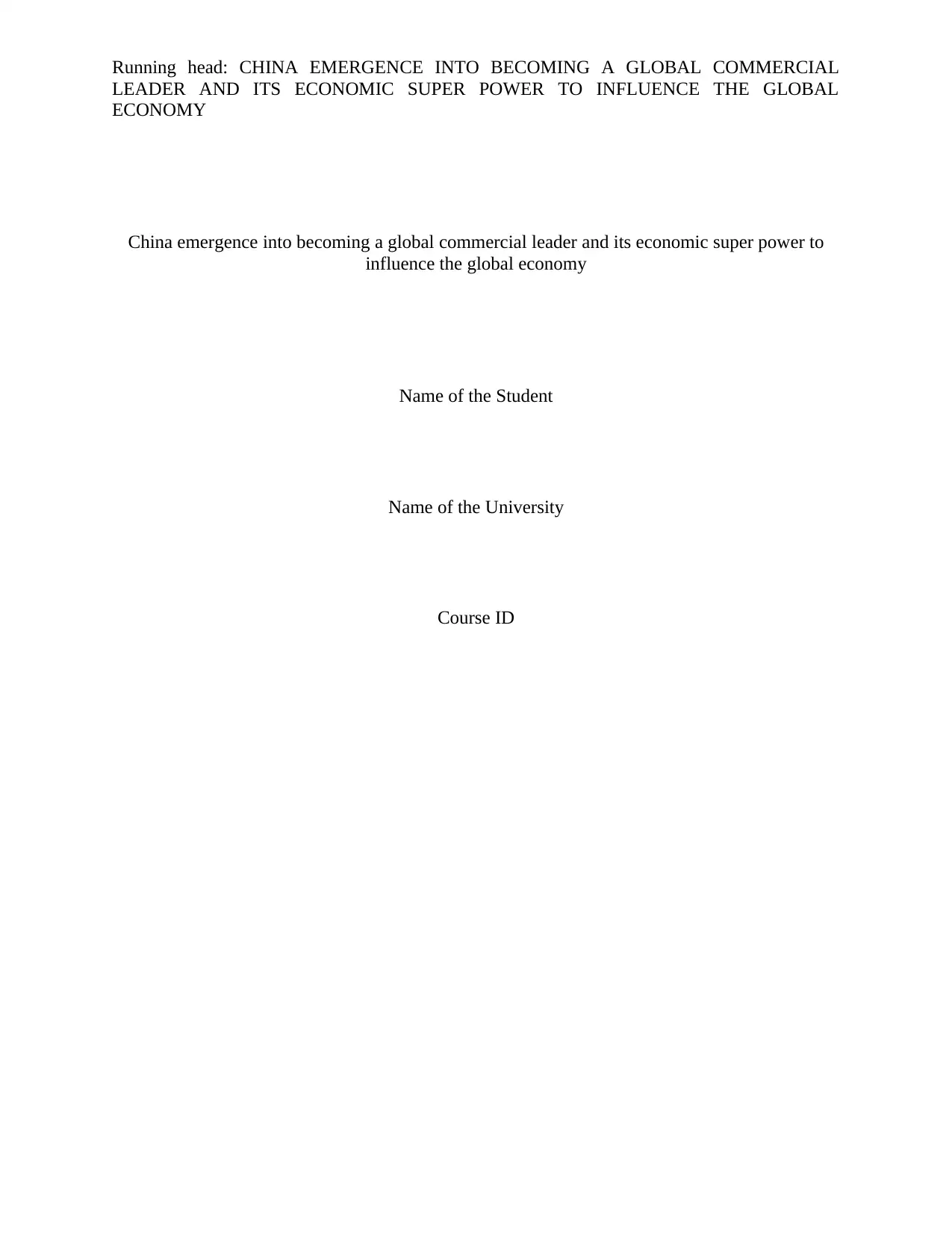
Running head: CHINA EMERGENCE INTO BECOMING A GLOBAL COMMERCIAL
LEADER AND ITS ECONOMIC SUPER POWER TO INFLUENCE THE GLOBAL
ECONOMY
China emergence into becoming a global commercial leader and its economic super power to
influence the global economy
Name of the Student
Name of the University
Course ID
LEADER AND ITS ECONOMIC SUPER POWER TO INFLUENCE THE GLOBAL
ECONOMY
China emergence into becoming a global commercial leader and its economic super power to
influence the global economy
Name of the Student
Name of the University
Course ID
Paraphrase This Document
Need a fresh take? Get an instant paraphrase of this document with our AI Paraphraser
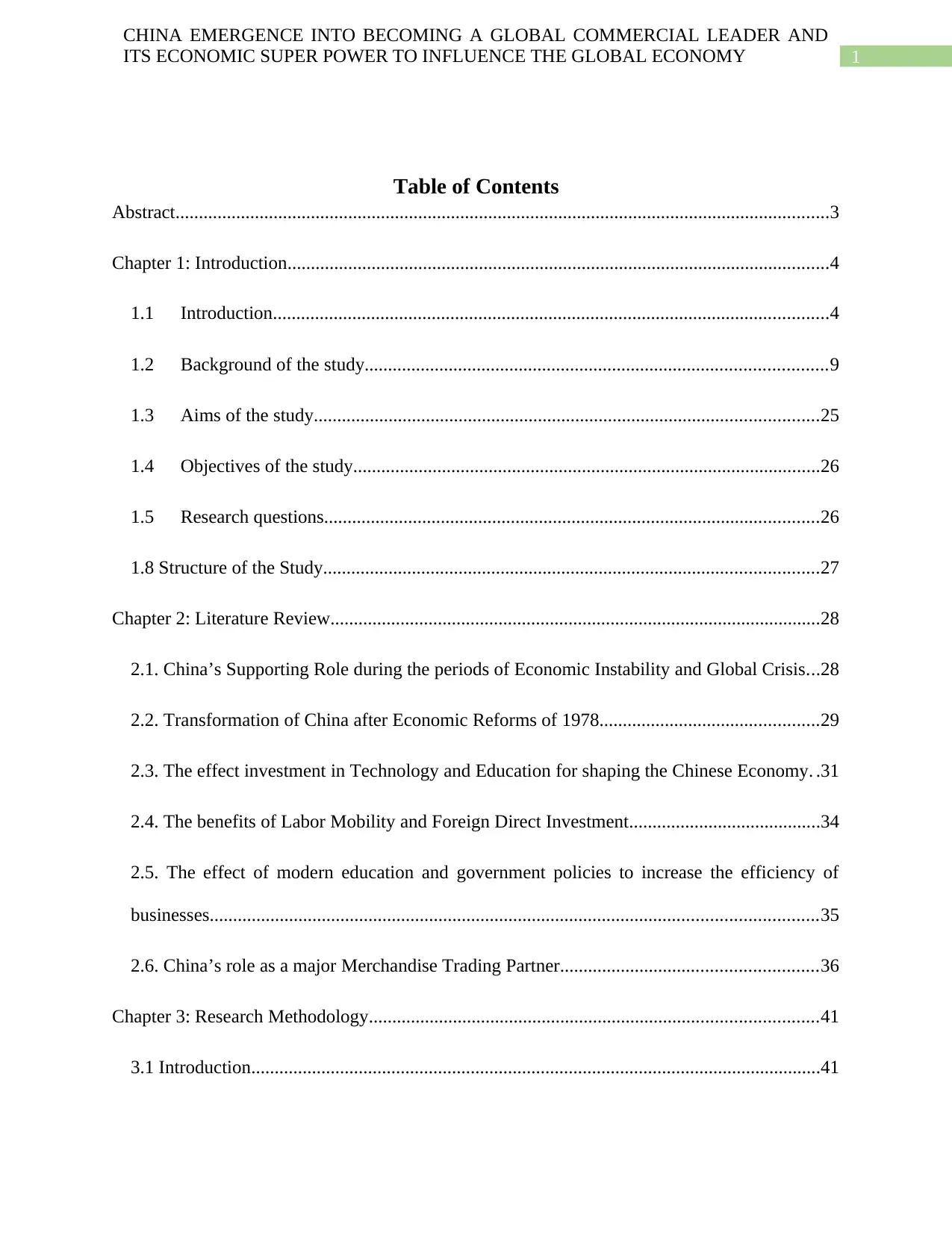
1
CHINA EMERGENCE INTO BECOMING A GLOBAL COMMERCIAL LEADER AND
ITS ECONOMIC SUPER POWER TO INFLUENCE THE GLOBAL ECONOMY
Table of Contents
Abstract............................................................................................................................................3
Chapter 1: Introduction....................................................................................................................4
1.1 Introduction.......................................................................................................................4
1.2 Background of the study...................................................................................................9
1.3 Aims of the study............................................................................................................25
1.4 Objectives of the study....................................................................................................26
1.5 Research questions..........................................................................................................26
1.8 Structure of the Study..........................................................................................................27
Chapter 2: Literature Review.........................................................................................................28
2.1. China’s Supporting Role during the periods of Economic Instability and Global Crisis...28
2.2. Transformation of China after Economic Reforms of 1978...............................................29
2.3. The effect investment in Technology and Education for shaping the Chinese Economy. .31
2.4. The benefits of Labor Mobility and Foreign Direct Investment.........................................34
2.5. The effect of modern education and government policies to increase the efficiency of
businesses..................................................................................................................................35
2.6. China’s role as a major Merchandise Trading Partner.......................................................36
Chapter 3: Research Methodology................................................................................................41
3.1 Introduction..........................................................................................................................41
CHINA EMERGENCE INTO BECOMING A GLOBAL COMMERCIAL LEADER AND
ITS ECONOMIC SUPER POWER TO INFLUENCE THE GLOBAL ECONOMY
Table of Contents
Abstract............................................................................................................................................3
Chapter 1: Introduction....................................................................................................................4
1.1 Introduction.......................................................................................................................4
1.2 Background of the study...................................................................................................9
1.3 Aims of the study............................................................................................................25
1.4 Objectives of the study....................................................................................................26
1.5 Research questions..........................................................................................................26
1.8 Structure of the Study..........................................................................................................27
Chapter 2: Literature Review.........................................................................................................28
2.1. China’s Supporting Role during the periods of Economic Instability and Global Crisis...28
2.2. Transformation of China after Economic Reforms of 1978...............................................29
2.3. The effect investment in Technology and Education for shaping the Chinese Economy. .31
2.4. The benefits of Labor Mobility and Foreign Direct Investment.........................................34
2.5. The effect of modern education and government policies to increase the efficiency of
businesses..................................................................................................................................35
2.6. China’s role as a major Merchandise Trading Partner.......................................................36
Chapter 3: Research Methodology................................................................................................41
3.1 Introduction..........................................................................................................................41
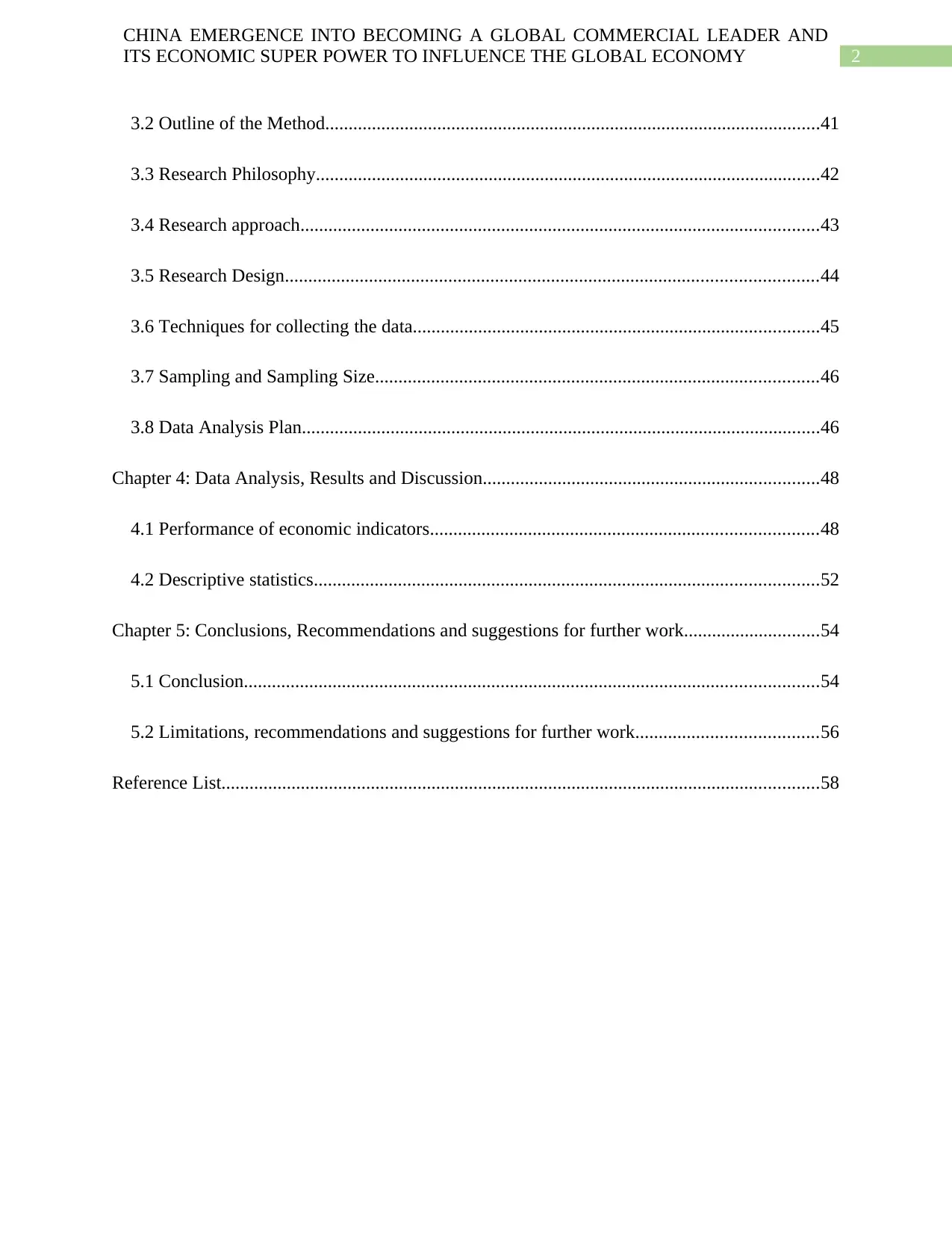
2
CHINA EMERGENCE INTO BECOMING A GLOBAL COMMERCIAL LEADER AND
ITS ECONOMIC SUPER POWER TO INFLUENCE THE GLOBAL ECONOMY
3.2 Outline of the Method..........................................................................................................41
3.3 Research Philosophy............................................................................................................42
3.4 Research approach...............................................................................................................43
3.5 Research Design..................................................................................................................44
3.6 Techniques for collecting the data.......................................................................................45
3.7 Sampling and Sampling Size...............................................................................................46
3.8 Data Analysis Plan...............................................................................................................46
Chapter 4: Data Analysis, Results and Discussion........................................................................48
4.1 Performance of economic indicators...................................................................................48
4.2 Descriptive statistics............................................................................................................52
Chapter 5: Conclusions, Recommendations and suggestions for further work.............................54
5.1 Conclusion...........................................................................................................................54
5.2 Limitations, recommendations and suggestions for further work.......................................56
Reference List................................................................................................................................58
CHINA EMERGENCE INTO BECOMING A GLOBAL COMMERCIAL LEADER AND
ITS ECONOMIC SUPER POWER TO INFLUENCE THE GLOBAL ECONOMY
3.2 Outline of the Method..........................................................................................................41
3.3 Research Philosophy............................................................................................................42
3.4 Research approach...............................................................................................................43
3.5 Research Design..................................................................................................................44
3.6 Techniques for collecting the data.......................................................................................45
3.7 Sampling and Sampling Size...............................................................................................46
3.8 Data Analysis Plan...............................................................................................................46
Chapter 4: Data Analysis, Results and Discussion........................................................................48
4.1 Performance of economic indicators...................................................................................48
4.2 Descriptive statistics............................................................................................................52
Chapter 5: Conclusions, Recommendations and suggestions for further work.............................54
5.1 Conclusion...........................................................................................................................54
5.2 Limitations, recommendations and suggestions for further work.......................................56
Reference List................................................................................................................................58
⊘ This is a preview!⊘
Do you want full access?
Subscribe today to unlock all pages.

Trusted by 1+ million students worldwide
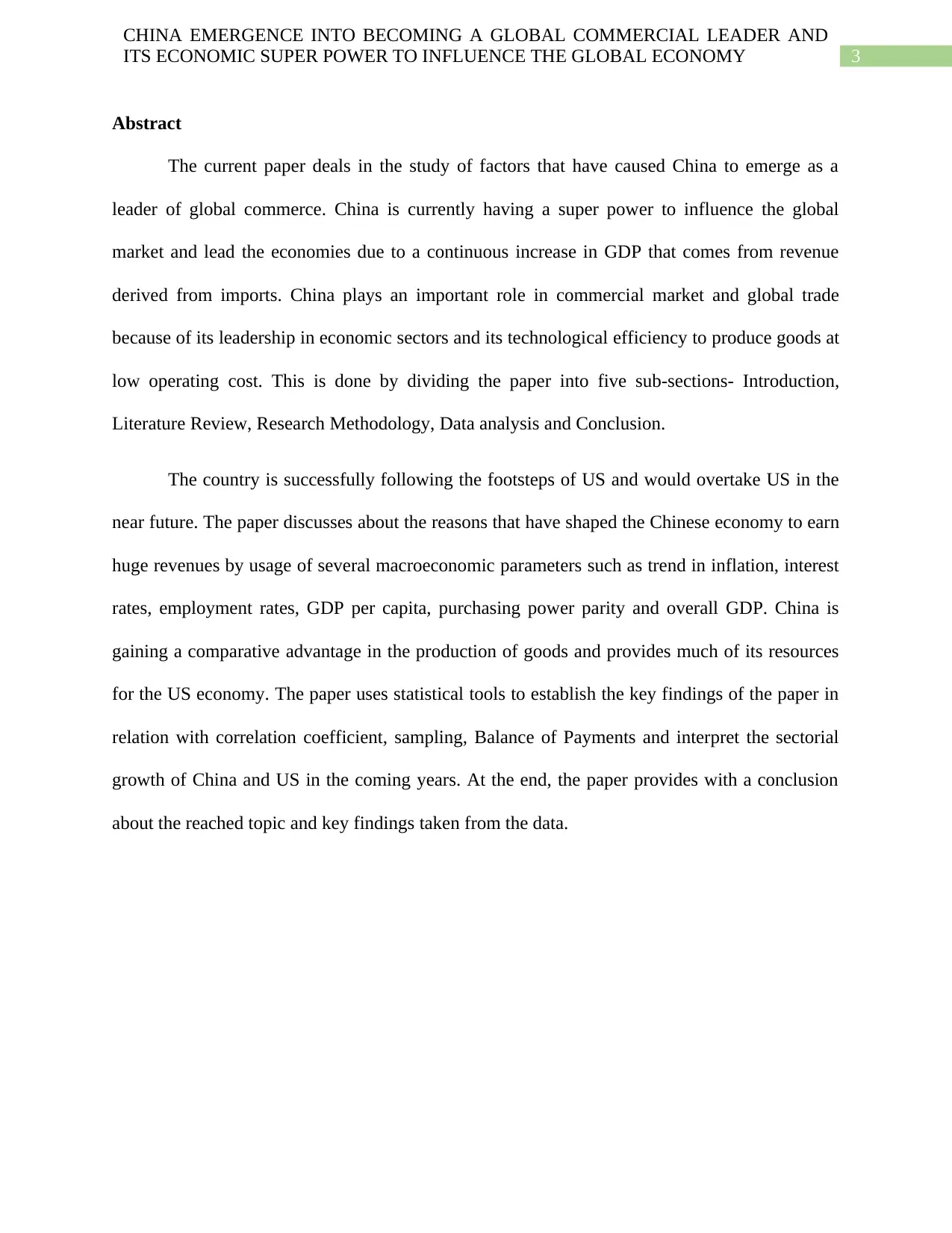
3
CHINA EMERGENCE INTO BECOMING A GLOBAL COMMERCIAL LEADER AND
ITS ECONOMIC SUPER POWER TO INFLUENCE THE GLOBAL ECONOMY
Abstract
The current paper deals in the study of factors that have caused China to emerge as a
leader of global commerce. China is currently having a super power to influence the global
market and lead the economies due to a continuous increase in GDP that comes from revenue
derived from imports. China plays an important role in commercial market and global trade
because of its leadership in economic sectors and its technological efficiency to produce goods at
low operating cost. This is done by dividing the paper into five sub-sections- Introduction,
Literature Review, Research Methodology, Data analysis and Conclusion.
The country is successfully following the footsteps of US and would overtake US in the
near future. The paper discusses about the reasons that have shaped the Chinese economy to earn
huge revenues by usage of several macroeconomic parameters such as trend in inflation, interest
rates, employment rates, GDP per capita, purchasing power parity and overall GDP. China is
gaining a comparative advantage in the production of goods and provides much of its resources
for the US economy. The paper uses statistical tools to establish the key findings of the paper in
relation with correlation coefficient, sampling, Balance of Payments and interpret the sectorial
growth of China and US in the coming years. At the end, the paper provides with a conclusion
about the reached topic and key findings taken from the data.
CHINA EMERGENCE INTO BECOMING A GLOBAL COMMERCIAL LEADER AND
ITS ECONOMIC SUPER POWER TO INFLUENCE THE GLOBAL ECONOMY
Abstract
The current paper deals in the study of factors that have caused China to emerge as a
leader of global commerce. China is currently having a super power to influence the global
market and lead the economies due to a continuous increase in GDP that comes from revenue
derived from imports. China plays an important role in commercial market and global trade
because of its leadership in economic sectors and its technological efficiency to produce goods at
low operating cost. This is done by dividing the paper into five sub-sections- Introduction,
Literature Review, Research Methodology, Data analysis and Conclusion.
The country is successfully following the footsteps of US and would overtake US in the
near future. The paper discusses about the reasons that have shaped the Chinese economy to earn
huge revenues by usage of several macroeconomic parameters such as trend in inflation, interest
rates, employment rates, GDP per capita, purchasing power parity and overall GDP. China is
gaining a comparative advantage in the production of goods and provides much of its resources
for the US economy. The paper uses statistical tools to establish the key findings of the paper in
relation with correlation coefficient, sampling, Balance of Payments and interpret the sectorial
growth of China and US in the coming years. At the end, the paper provides with a conclusion
about the reached topic and key findings taken from the data.
Paraphrase This Document
Need a fresh take? Get an instant paraphrase of this document with our AI Paraphraser
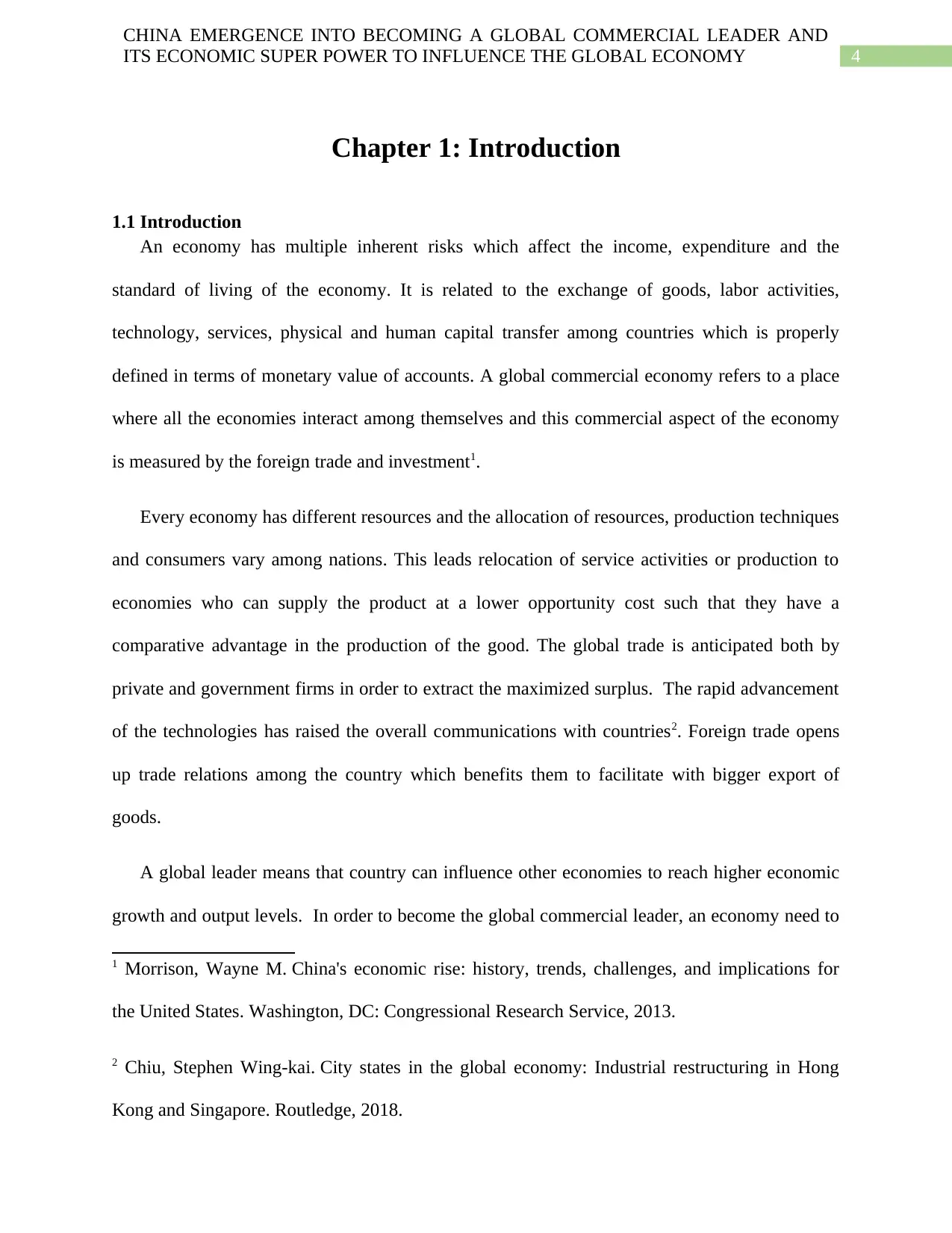
4
CHINA EMERGENCE INTO BECOMING A GLOBAL COMMERCIAL LEADER AND
ITS ECONOMIC SUPER POWER TO INFLUENCE THE GLOBAL ECONOMY
Chapter 1: Introduction
1.1 Introduction
An economy has multiple inherent risks which affect the income, expenditure and the
standard of living of the economy. It is related to the exchange of goods, labor activities,
technology, services, physical and human capital transfer among countries which is properly
defined in terms of monetary value of accounts. A global commercial economy refers to a place
where all the economies interact among themselves and this commercial aspect of the economy
is measured by the foreign trade and investment1.
Every economy has different resources and the allocation of resources, production techniques
and consumers vary among nations. This leads relocation of service activities or production to
economies who can supply the product at a lower opportunity cost such that they have a
comparative advantage in the production of the good. The global trade is anticipated both by
private and government firms in order to extract the maximized surplus. The rapid advancement
of the technologies has raised the overall communications with countries2. Foreign trade opens
up trade relations among the country which benefits them to facilitate with bigger export of
goods.
A global leader means that country can influence other economies to reach higher economic
growth and output levels. In order to become the global commercial leader, an economy need to
1 Morrison, Wayne M. China's economic rise: history, trends, challenges, and implications for
the United States. Washington, DC: Congressional Research Service, 2013.
2 Chiu, Stephen Wing-kai. City states in the global economy: Industrial restructuring in Hong
Kong and Singapore. Routledge, 2018.
CHINA EMERGENCE INTO BECOMING A GLOBAL COMMERCIAL LEADER AND
ITS ECONOMIC SUPER POWER TO INFLUENCE THE GLOBAL ECONOMY
Chapter 1: Introduction
1.1 Introduction
An economy has multiple inherent risks which affect the income, expenditure and the
standard of living of the economy. It is related to the exchange of goods, labor activities,
technology, services, physical and human capital transfer among countries which is properly
defined in terms of monetary value of accounts. A global commercial economy refers to a place
where all the economies interact among themselves and this commercial aspect of the economy
is measured by the foreign trade and investment1.
Every economy has different resources and the allocation of resources, production techniques
and consumers vary among nations. This leads relocation of service activities or production to
economies who can supply the product at a lower opportunity cost such that they have a
comparative advantage in the production of the good. The global trade is anticipated both by
private and government firms in order to extract the maximized surplus. The rapid advancement
of the technologies has raised the overall communications with countries2. Foreign trade opens
up trade relations among the country which benefits them to facilitate with bigger export of
goods.
A global leader means that country can influence other economies to reach higher economic
growth and output levels. In order to become the global commercial leader, an economy need to
1 Morrison, Wayne M. China's economic rise: history, trends, challenges, and implications for
the United States. Washington, DC: Congressional Research Service, 2013.
2 Chiu, Stephen Wing-kai. City states in the global economy: Industrial restructuring in Hong
Kong and Singapore. Routledge, 2018.
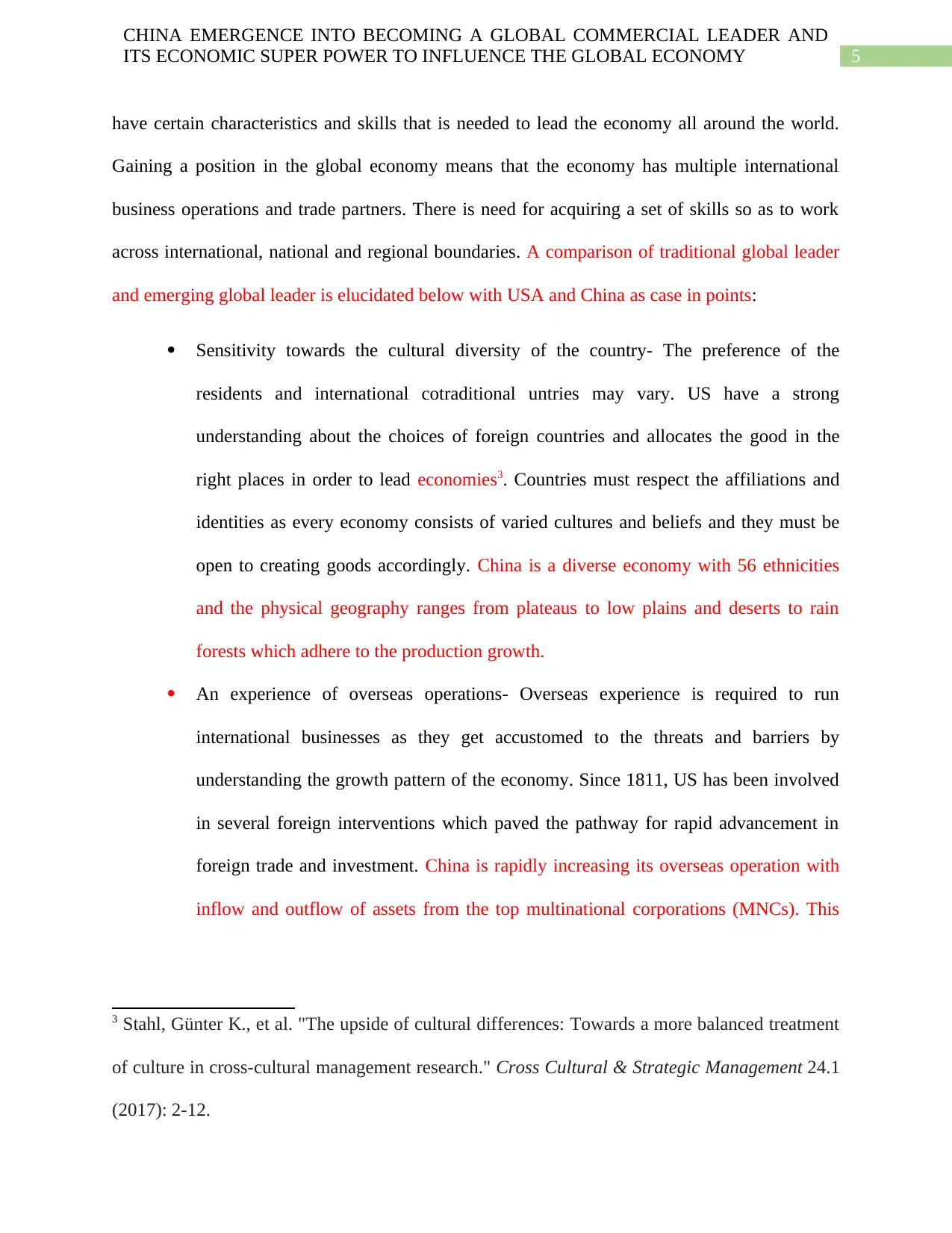
5
CHINA EMERGENCE INTO BECOMING A GLOBAL COMMERCIAL LEADER AND
ITS ECONOMIC SUPER POWER TO INFLUENCE THE GLOBAL ECONOMY
have certain characteristics and skills that is needed to lead the economy all around the world.
Gaining a position in the global economy means that the economy has multiple international
business operations and trade partners. There is need for acquiring a set of skills so as to work
across international, national and regional boundaries. A comparison of traditional global leader
and emerging global leader is elucidated below with USA and China as case in points:
Sensitivity towards the cultural diversity of the country- The preference of the
residents and international cotraditional untries may vary. US have a strong
understanding about the choices of foreign countries and allocates the good in the
right places in order to lead economies3. Countries must respect the affiliations and
identities as every economy consists of varied cultures and beliefs and they must be
open to creating goods accordingly. China is a diverse economy with 56 ethnicities
and the physical geography ranges from plateaus to low plains and deserts to rain
forests which adhere to the production growth.
An experience of overseas operations- Overseas experience is required to run
international businesses as they get accustomed to the threats and barriers by
understanding the growth pattern of the economy. Since 1811, US has been involved
in several foreign interventions which paved the pathway for rapid advancement in
foreign trade and investment. China is rapidly increasing its overseas operation with
inflow and outflow of assets from the top multinational corporations (MNCs). This
3 Stahl, Günter K., et al. "The upside of cultural differences: Towards a more balanced treatment
of culture in cross-cultural management research." Cross Cultural & Strategic Management 24.1
(2017): 2-12.
CHINA EMERGENCE INTO BECOMING A GLOBAL COMMERCIAL LEADER AND
ITS ECONOMIC SUPER POWER TO INFLUENCE THE GLOBAL ECONOMY
have certain characteristics and skills that is needed to lead the economy all around the world.
Gaining a position in the global economy means that the economy has multiple international
business operations and trade partners. There is need for acquiring a set of skills so as to work
across international, national and regional boundaries. A comparison of traditional global leader
and emerging global leader is elucidated below with USA and China as case in points:
Sensitivity towards the cultural diversity of the country- The preference of the
residents and international cotraditional untries may vary. US have a strong
understanding about the choices of foreign countries and allocates the good in the
right places in order to lead economies3. Countries must respect the affiliations and
identities as every economy consists of varied cultures and beliefs and they must be
open to creating goods accordingly. China is a diverse economy with 56 ethnicities
and the physical geography ranges from plateaus to low plains and deserts to rain
forests which adhere to the production growth.
An experience of overseas operations- Overseas experience is required to run
international businesses as they get accustomed to the threats and barriers by
understanding the growth pattern of the economy. Since 1811, US has been involved
in several foreign interventions which paved the pathway for rapid advancement in
foreign trade and investment. China is rapidly increasing its overseas operation with
inflow and outflow of assets from the top multinational corporations (MNCs). This
3 Stahl, Günter K., et al. "The upside of cultural differences: Towards a more balanced treatment
of culture in cross-cultural management research." Cross Cultural & Strategic Management 24.1
(2017): 2-12.
⊘ This is a preview!⊘
Do you want full access?
Subscribe today to unlock all pages.

Trusted by 1+ million students worldwide
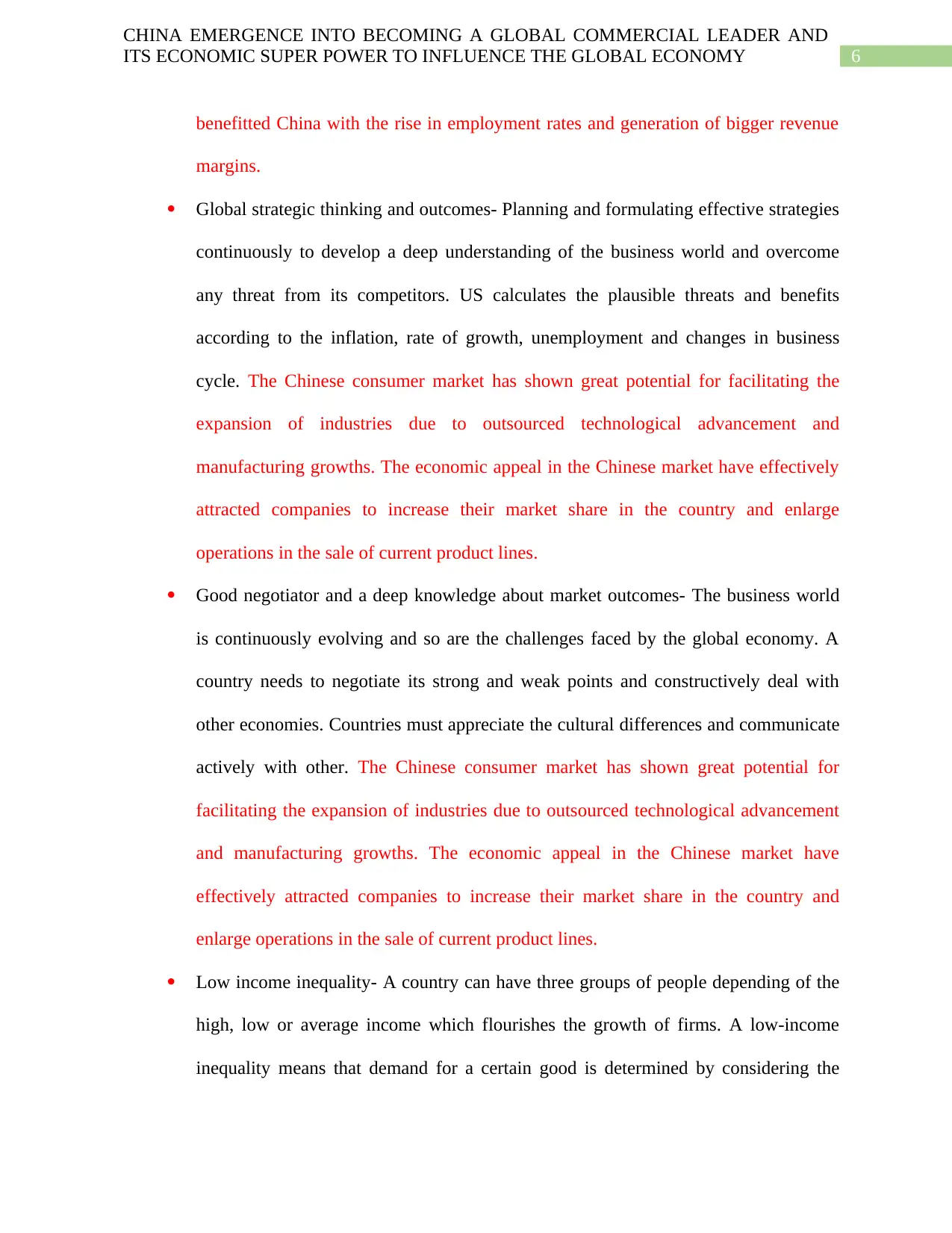
6
CHINA EMERGENCE INTO BECOMING A GLOBAL COMMERCIAL LEADER AND
ITS ECONOMIC SUPER POWER TO INFLUENCE THE GLOBAL ECONOMY
benefitted China with the rise in employment rates and generation of bigger revenue
margins.
Global strategic thinking and outcomes- Planning and formulating effective strategies
continuously to develop a deep understanding of the business world and overcome
any threat from its competitors. US calculates the plausible threats and benefits
according to the inflation, rate of growth, unemployment and changes in business
cycle. The Chinese consumer market has shown great potential for facilitating the
expansion of industries due to outsourced technological advancement and
manufacturing growths. The economic appeal in the Chinese market have effectively
attracted companies to increase their market share in the country and enlarge
operations in the sale of current product lines.
Good negotiator and a deep knowledge about market outcomes- The business world
is continuously evolving and so are the challenges faced by the global economy. A
country needs to negotiate its strong and weak points and constructively deal with
other economies. Countries must appreciate the cultural differences and communicate
actively with other. The Chinese consumer market has shown great potential for
facilitating the expansion of industries due to outsourced technological advancement
and manufacturing growths. The economic appeal in the Chinese market have
effectively attracted companies to increase their market share in the country and
enlarge operations in the sale of current product lines.
Low income inequality- A country can have three groups of people depending of the
high, low or average income which flourishes the growth of firms. A low-income
inequality means that demand for a certain good is determined by considering the
CHINA EMERGENCE INTO BECOMING A GLOBAL COMMERCIAL LEADER AND
ITS ECONOMIC SUPER POWER TO INFLUENCE THE GLOBAL ECONOMY
benefitted China with the rise in employment rates and generation of bigger revenue
margins.
Global strategic thinking and outcomes- Planning and formulating effective strategies
continuously to develop a deep understanding of the business world and overcome
any threat from its competitors. US calculates the plausible threats and benefits
according to the inflation, rate of growth, unemployment and changes in business
cycle. The Chinese consumer market has shown great potential for facilitating the
expansion of industries due to outsourced technological advancement and
manufacturing growths. The economic appeal in the Chinese market have effectively
attracted companies to increase their market share in the country and enlarge
operations in the sale of current product lines.
Good negotiator and a deep knowledge about market outcomes- The business world
is continuously evolving and so are the challenges faced by the global economy. A
country needs to negotiate its strong and weak points and constructively deal with
other economies. Countries must appreciate the cultural differences and communicate
actively with other. The Chinese consumer market has shown great potential for
facilitating the expansion of industries due to outsourced technological advancement
and manufacturing growths. The economic appeal in the Chinese market have
effectively attracted companies to increase their market share in the country and
enlarge operations in the sale of current product lines.
Low income inequality- A country can have three groups of people depending of the
high, low or average income which flourishes the growth of firms. A low-income
inequality means that demand for a certain good is determined by considering the
Paraphrase This Document
Need a fresh take? Get an instant paraphrase of this document with our AI Paraphraser
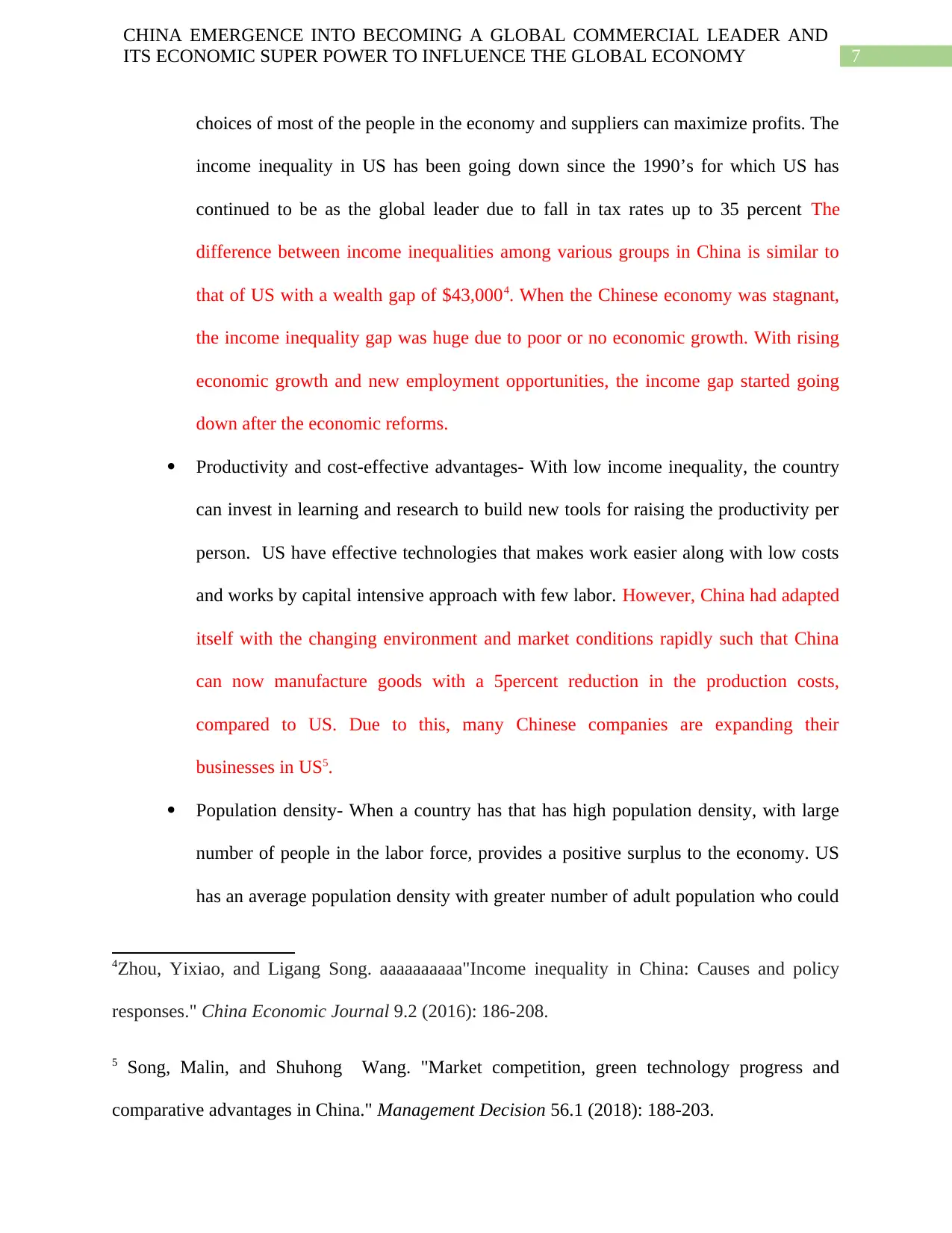
7
CHINA EMERGENCE INTO BECOMING A GLOBAL COMMERCIAL LEADER AND
ITS ECONOMIC SUPER POWER TO INFLUENCE THE GLOBAL ECONOMY
choices of most of the people in the economy and suppliers can maximize profits. The
income inequality in US has been going down since the 1990’s for which US has
continued to be as the global leader due to fall in tax rates up to 35 percent The
difference between income inequalities among various groups in China is similar to
that of US with a wealth gap of $43,0004. When the Chinese economy was stagnant,
the income inequality gap was huge due to poor or no economic growth. With rising
economic growth and new employment opportunities, the income gap started going
down after the economic reforms.
Productivity and cost-effective advantages- With low income inequality, the country
can invest in learning and research to build new tools for raising the productivity per
person. US have effective technologies that makes work easier along with low costs
and works by capital intensive approach with few labor. However, China had adapted
itself with the changing environment and market conditions rapidly such that China
can now manufacture goods with a 5percent reduction in the production costs,
compared to US. Due to this, many Chinese companies are expanding their
businesses in US5.
Population density- When a country has that has high population density, with large
number of people in the labor force, provides a positive surplus to the economy. US
has an average population density with greater number of adult population who could
4Zhou, Yixiao, and Ligang Song. aaaaaaaaaa"Income inequality in China: Causes and policy
responses." China Economic Journal 9.2 (2016): 186-208.
5 Song, Malin, and Shuhong Wang. "Market competition, green technology progress and
comparative advantages in China." Management Decision 56.1 (2018): 188-203.
CHINA EMERGENCE INTO BECOMING A GLOBAL COMMERCIAL LEADER AND
ITS ECONOMIC SUPER POWER TO INFLUENCE THE GLOBAL ECONOMY
choices of most of the people in the economy and suppliers can maximize profits. The
income inequality in US has been going down since the 1990’s for which US has
continued to be as the global leader due to fall in tax rates up to 35 percent The
difference between income inequalities among various groups in China is similar to
that of US with a wealth gap of $43,0004. When the Chinese economy was stagnant,
the income inequality gap was huge due to poor or no economic growth. With rising
economic growth and new employment opportunities, the income gap started going
down after the economic reforms.
Productivity and cost-effective advantages- With low income inequality, the country
can invest in learning and research to build new tools for raising the productivity per
person. US have effective technologies that makes work easier along with low costs
and works by capital intensive approach with few labor. However, China had adapted
itself with the changing environment and market conditions rapidly such that China
can now manufacture goods with a 5percent reduction in the production costs,
compared to US. Due to this, many Chinese companies are expanding their
businesses in US5.
Population density- When a country has that has high population density, with large
number of people in the labor force, provides a positive surplus to the economy. US
has an average population density with greater number of adult population who could
4Zhou, Yixiao, and Ligang Song. aaaaaaaaaa"Income inequality in China: Causes and policy
responses." China Economic Journal 9.2 (2016): 186-208.
5 Song, Malin, and Shuhong Wang. "Market competition, green technology progress and
comparative advantages in China." Management Decision 56.1 (2018): 188-203.
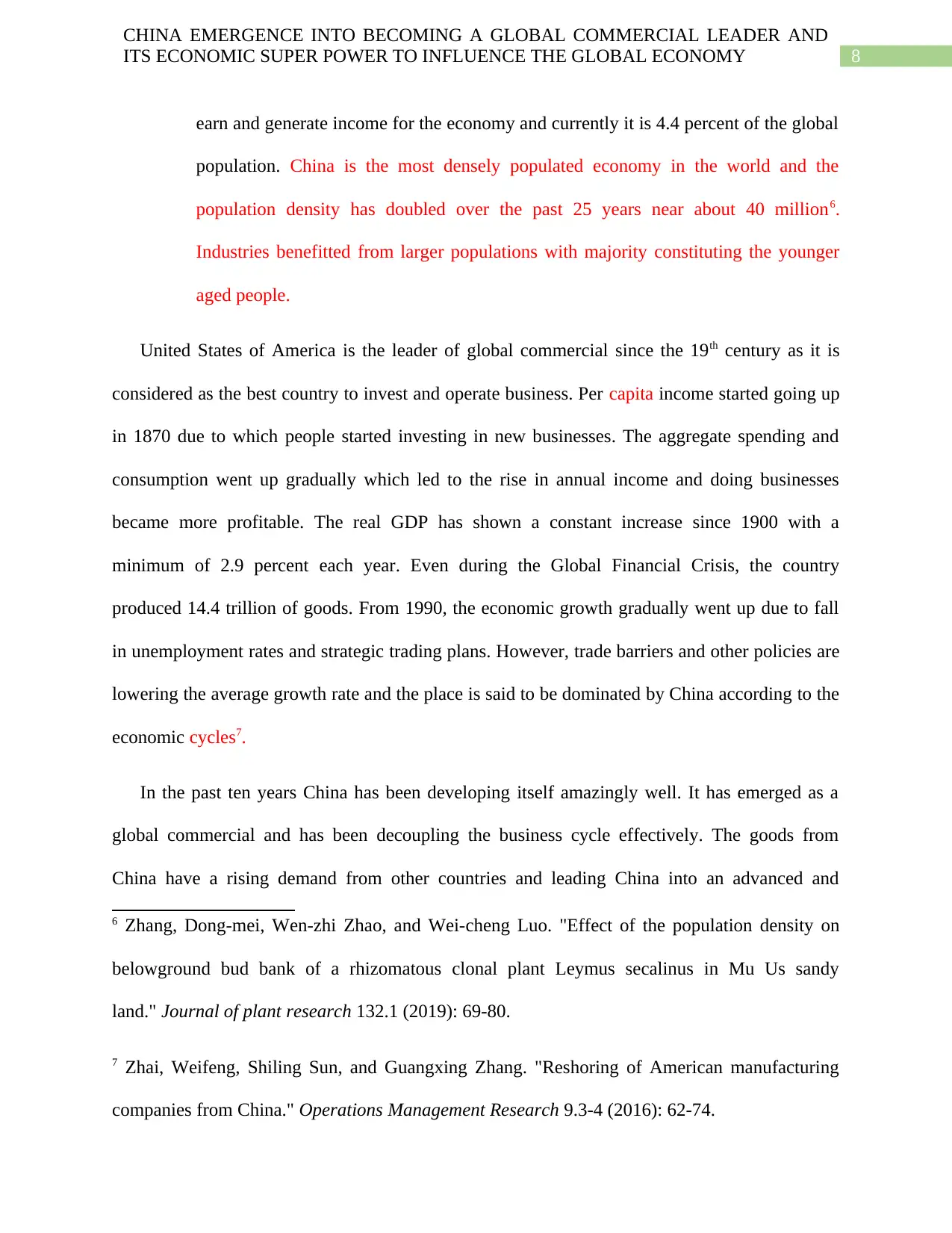
8
CHINA EMERGENCE INTO BECOMING A GLOBAL COMMERCIAL LEADER AND
ITS ECONOMIC SUPER POWER TO INFLUENCE THE GLOBAL ECONOMY
earn and generate income for the economy and currently it is 4.4 percent of the global
population. China is the most densely populated economy in the world and the
population density has doubled over the past 25 years near about 40 million6.
Industries benefitted from larger populations with majority constituting the younger
aged people.
United States of America is the leader of global commercial since the 19th century as it is
considered as the best country to invest and operate business. Per capita income started going up
in 1870 due to which people started investing in new businesses. The aggregate spending and
consumption went up gradually which led to the rise in annual income and doing businesses
became more profitable. The real GDP has shown a constant increase since 1900 with a
minimum of 2.9 percent each year. Even during the Global Financial Crisis, the country
produced 14.4 trillion of goods. From 1990, the economic growth gradually went up due to fall
in unemployment rates and strategic trading plans. However, trade barriers and other policies are
lowering the average growth rate and the place is said to be dominated by China according to the
economic cycles7.
In the past ten years China has been developing itself amazingly well. It has emerged as a
global commercial and has been decoupling the business cycle effectively. The goods from
China have a rising demand from other countries and leading China into an advanced and
6 Zhang, Dong-mei, Wen-zhi Zhao, and Wei-cheng Luo. "Effect of the population density on
belowground bud bank of a rhizomatous clonal plant Leymus secalinus in Mu Us sandy
land." Journal of plant research 132.1 (2019): 69-80.
7 Zhai, Weifeng, Shiling Sun, and Guangxing Zhang. "Reshoring of American manufacturing
companies from China." Operations Management Research 9.3-4 (2016): 62-74.
CHINA EMERGENCE INTO BECOMING A GLOBAL COMMERCIAL LEADER AND
ITS ECONOMIC SUPER POWER TO INFLUENCE THE GLOBAL ECONOMY
earn and generate income for the economy and currently it is 4.4 percent of the global
population. China is the most densely populated economy in the world and the
population density has doubled over the past 25 years near about 40 million6.
Industries benefitted from larger populations with majority constituting the younger
aged people.
United States of America is the leader of global commercial since the 19th century as it is
considered as the best country to invest and operate business. Per capita income started going up
in 1870 due to which people started investing in new businesses. The aggregate spending and
consumption went up gradually which led to the rise in annual income and doing businesses
became more profitable. The real GDP has shown a constant increase since 1900 with a
minimum of 2.9 percent each year. Even during the Global Financial Crisis, the country
produced 14.4 trillion of goods. From 1990, the economic growth gradually went up due to fall
in unemployment rates and strategic trading plans. However, trade barriers and other policies are
lowering the average growth rate and the place is said to be dominated by China according to the
economic cycles7.
In the past ten years China has been developing itself amazingly well. It has emerged as a
global commercial and has been decoupling the business cycle effectively. The goods from
China have a rising demand from other countries and leading China into an advanced and
6 Zhang, Dong-mei, Wen-zhi Zhao, and Wei-cheng Luo. "Effect of the population density on
belowground bud bank of a rhizomatous clonal plant Leymus secalinus in Mu Us sandy
land." Journal of plant research 132.1 (2019): 69-80.
7 Zhai, Weifeng, Shiling Sun, and Guangxing Zhang. "Reshoring of American manufacturing
companies from China." Operations Management Research 9.3-4 (2016): 62-74.
⊘ This is a preview!⊘
Do you want full access?
Subscribe today to unlock all pages.

Trusted by 1+ million students worldwide
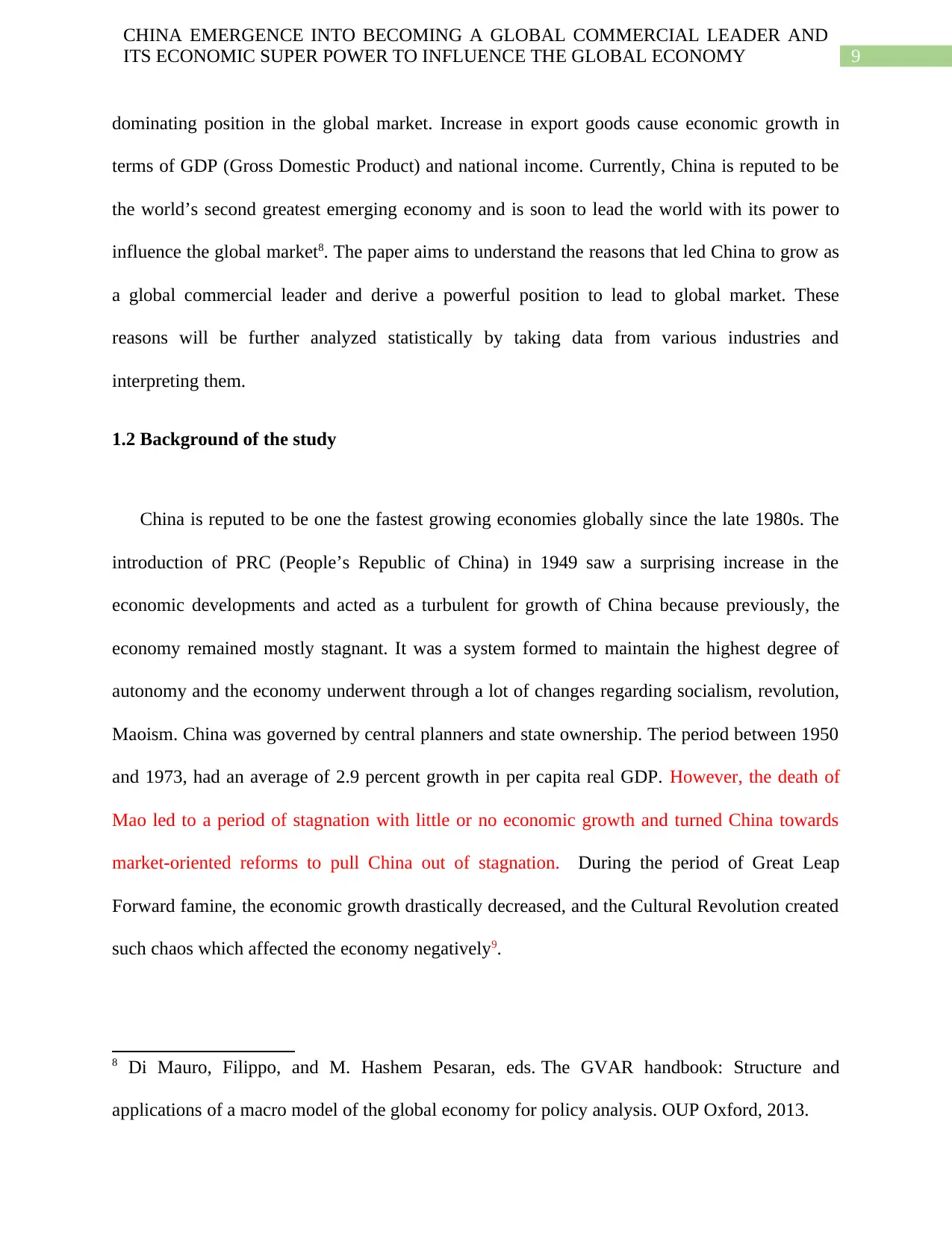
9
CHINA EMERGENCE INTO BECOMING A GLOBAL COMMERCIAL LEADER AND
ITS ECONOMIC SUPER POWER TO INFLUENCE THE GLOBAL ECONOMY
dominating position in the global market. Increase in export goods cause economic growth in
terms of GDP (Gross Domestic Product) and national income. Currently, China is reputed to be
the world’s second greatest emerging economy and is soon to lead the world with its power to
influence the global market8. The paper aims to understand the reasons that led China to grow as
a global commercial leader and derive a powerful position to lead to global market. These
reasons will be further analyzed statistically by taking data from various industries and
interpreting them.
1.2 Background of the study
China is reputed to be one the fastest growing economies globally since the late 1980s. The
introduction of PRC (People’s Republic of China) in 1949 saw a surprising increase in the
economic developments and acted as a turbulent for growth of China because previously, the
economy remained mostly stagnant. It was a system formed to maintain the highest degree of
autonomy and the economy underwent through a lot of changes regarding socialism, revolution,
Maoism. China was governed by central planners and state ownership. The period between 1950
and 1973, had an average of 2.9 percent growth in per capita real GDP. However, the death of
Mao led to a period of stagnation with little or no economic growth and turned China towards
market-oriented reforms to pull China out of stagnation. During the period of Great Leap
Forward famine, the economic growth drastically decreased, and the Cultural Revolution created
such chaos which affected the economy negatively9.
8 Di Mauro, Filippo, and M. Hashem Pesaran, eds. The GVAR handbook: Structure and
applications of a macro model of the global economy for policy analysis. OUP Oxford, 2013.
CHINA EMERGENCE INTO BECOMING A GLOBAL COMMERCIAL LEADER AND
ITS ECONOMIC SUPER POWER TO INFLUENCE THE GLOBAL ECONOMY
dominating position in the global market. Increase in export goods cause economic growth in
terms of GDP (Gross Domestic Product) and national income. Currently, China is reputed to be
the world’s second greatest emerging economy and is soon to lead the world with its power to
influence the global market8. The paper aims to understand the reasons that led China to grow as
a global commercial leader and derive a powerful position to lead to global market. These
reasons will be further analyzed statistically by taking data from various industries and
interpreting them.
1.2 Background of the study
China is reputed to be one the fastest growing economies globally since the late 1980s. The
introduction of PRC (People’s Republic of China) in 1949 saw a surprising increase in the
economic developments and acted as a turbulent for growth of China because previously, the
economy remained mostly stagnant. It was a system formed to maintain the highest degree of
autonomy and the economy underwent through a lot of changes regarding socialism, revolution,
Maoism. China was governed by central planners and state ownership. The period between 1950
and 1973, had an average of 2.9 percent growth in per capita real GDP. However, the death of
Mao led to a period of stagnation with little or no economic growth and turned China towards
market-oriented reforms to pull China out of stagnation. During the period of Great Leap
Forward famine, the economic growth drastically decreased, and the Cultural Revolution created
such chaos which affected the economy negatively9.
8 Di Mauro, Filippo, and M. Hashem Pesaran, eds. The GVAR handbook: Structure and
applications of a macro model of the global economy for policy analysis. OUP Oxford, 2013.
Paraphrase This Document
Need a fresh take? Get an instant paraphrase of this document with our AI Paraphraser

10
CHINA EMERGENCE INTO BECOMING A GLOBAL COMMERCIAL LEADER AND
ITS ECONOMIC SUPER POWER TO INFLUENCE THE GLOBAL ECONOMY
In the late 1970s and early 1980s, the Communist Party opened up foreign investment and
permitted entrepreneurs to open new businesses. In the latter part of 1980s and 19990s,
privatization was established which contracted out much of state-owned industries into private
firms by the shifting of protectionist policies, price controls and regulations10. Only the state
earned monopolies like that of petroleum and banking remained and the rest were converted into
private firms which accounted to 70 percent of China’s GDP by 2005. Overall, there occurred
unprecedented growth of 9.5 percent each year, from 1978 to 2013. China experienced major
improvements in social stability and the living standards of the people. This led China to emerge
as an ideal backbone of the global economy from an isolated socialist state. The rise in rate of
growth at a constant pace was due the enormous mobilization of resources and shifting the
executive control for public to private ownership sectors improved the efficiency in managing
the available resources11.
China had limited resources for investment which prevented China from importing or
producing advanced equipment. China being a vast country consisted of varying living standards
from wide scale poverty to relative prosperity. This gap has made China to stay in a weaker
9 Kim, Seonghoon, Belton Fleisher, and Jessica Ya Sun. "The Long‐term Health Effects of Fetal
Malnutrition: Evidence from the 1959–1961 China Great Leap Forward Famine." Health
economics 26.10 (2017): 1264-1277.
10 Neilson, Jeffrey, Bill Pritchard, and Henry Wai-chung Yeung. "Global value chains and global
production networks in the changing international political economy: An introduction." Review
of International Political Economy 21.1 (2014): 1-8.
11 Leutert, Wendy. "Challenges ahead in China’s reform of state-owned enterprises." Asia
policy 21 (2016): 83-100.
CHINA EMERGENCE INTO BECOMING A GLOBAL COMMERCIAL LEADER AND
ITS ECONOMIC SUPER POWER TO INFLUENCE THE GLOBAL ECONOMY
In the late 1970s and early 1980s, the Communist Party opened up foreign investment and
permitted entrepreneurs to open new businesses. In the latter part of 1980s and 19990s,
privatization was established which contracted out much of state-owned industries into private
firms by the shifting of protectionist policies, price controls and regulations10. Only the state
earned monopolies like that of petroleum and banking remained and the rest were converted into
private firms which accounted to 70 percent of China’s GDP by 2005. Overall, there occurred
unprecedented growth of 9.5 percent each year, from 1978 to 2013. China experienced major
improvements in social stability and the living standards of the people. This led China to emerge
as an ideal backbone of the global economy from an isolated socialist state. The rise in rate of
growth at a constant pace was due the enormous mobilization of resources and shifting the
executive control for public to private ownership sectors improved the efficiency in managing
the available resources11.
China had limited resources for investment which prevented China from importing or
producing advanced equipment. China being a vast country consisted of varying living standards
from wide scale poverty to relative prosperity. This gap has made China to stay in a weaker
9 Kim, Seonghoon, Belton Fleisher, and Jessica Ya Sun. "The Long‐term Health Effects of Fetal
Malnutrition: Evidence from the 1959–1961 China Great Leap Forward Famine." Health
economics 26.10 (2017): 1264-1277.
10 Neilson, Jeffrey, Bill Pritchard, and Henry Wai-chung Yeung. "Global value chains and global
production networks in the changing international political economy: An introduction." Review
of International Political Economy 21.1 (2014): 1-8.
11 Leutert, Wendy. "Challenges ahead in China’s reform of state-owned enterprises." Asia
policy 21 (2016): 83-100.
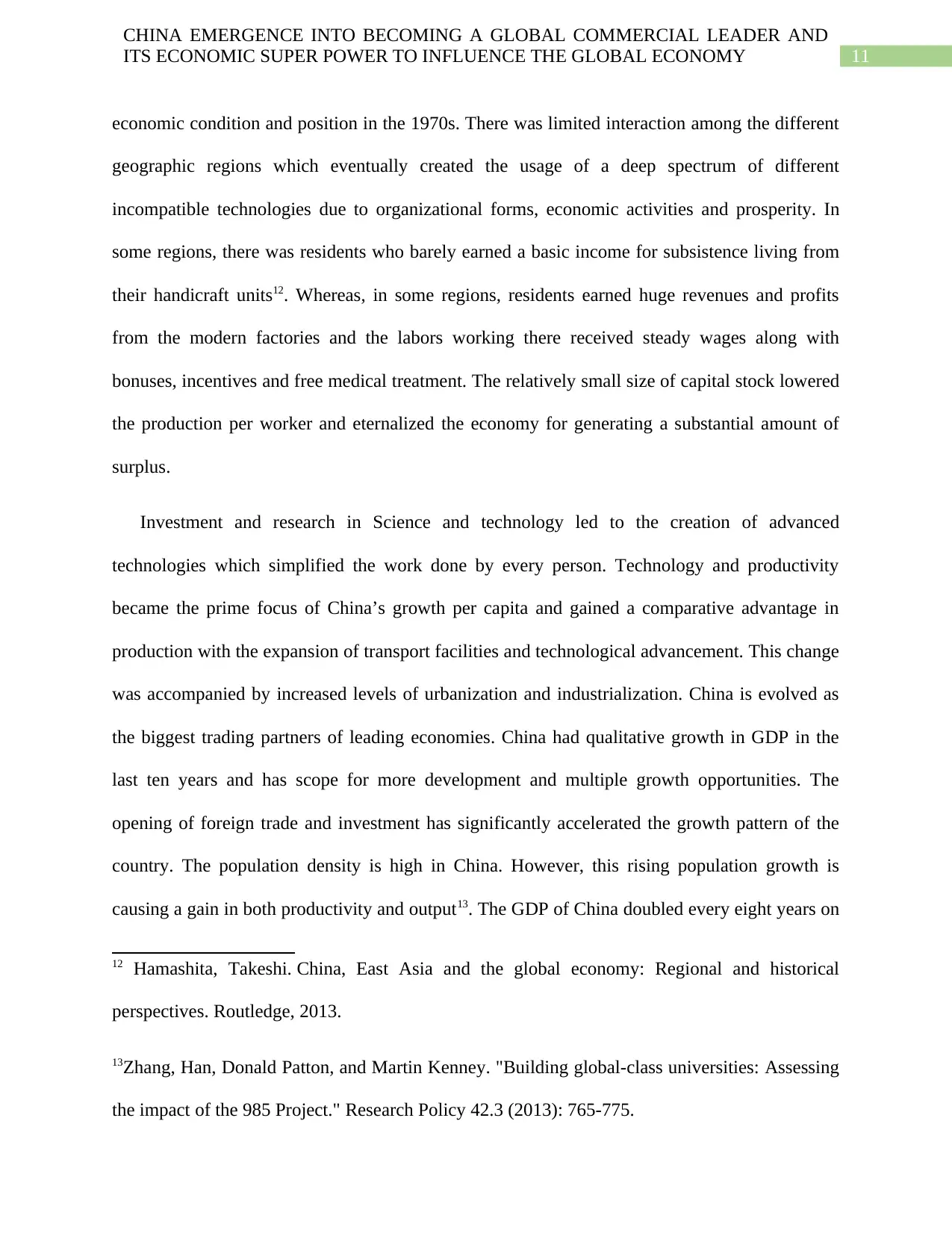
11
CHINA EMERGENCE INTO BECOMING A GLOBAL COMMERCIAL LEADER AND
ITS ECONOMIC SUPER POWER TO INFLUENCE THE GLOBAL ECONOMY
economic condition and position in the 1970s. There was limited interaction among the different
geographic regions which eventually created the usage of a deep spectrum of different
incompatible technologies due to organizational forms, economic activities and prosperity. In
some regions, there was residents who barely earned a basic income for subsistence living from
their handicraft units12. Whereas, in some regions, residents earned huge revenues and profits
from the modern factories and the labors working there received steady wages along with
bonuses, incentives and free medical treatment. The relatively small size of capital stock lowered
the production per worker and eternalized the economy for generating a substantial amount of
surplus.
Investment and research in Science and technology led to the creation of advanced
technologies which simplified the work done by every person. Technology and productivity
became the prime focus of China’s growth per capita and gained a comparative advantage in
production with the expansion of transport facilities and technological advancement. This change
was accompanied by increased levels of urbanization and industrialization. China is evolved as
the biggest trading partners of leading economies. China had qualitative growth in GDP in the
last ten years and has scope for more development and multiple growth opportunities. The
opening of foreign trade and investment has significantly accelerated the growth pattern of the
country. The population density is high in China. However, this rising population growth is
causing a gain in both productivity and output13. The GDP of China doubled every eight years on
12 Hamashita, Takeshi. China, East Asia and the global economy: Regional and historical
perspectives. Routledge, 2013.
13Zhang, Han, Donald Patton, and Martin Kenney. "Building global-class universities: Assessing
the impact of the 985 Project." Research Policy 42.3 (2013): 765-775.
CHINA EMERGENCE INTO BECOMING A GLOBAL COMMERCIAL LEADER AND
ITS ECONOMIC SUPER POWER TO INFLUENCE THE GLOBAL ECONOMY
economic condition and position in the 1970s. There was limited interaction among the different
geographic regions which eventually created the usage of a deep spectrum of different
incompatible technologies due to organizational forms, economic activities and prosperity. In
some regions, there was residents who barely earned a basic income for subsistence living from
their handicraft units12. Whereas, in some regions, residents earned huge revenues and profits
from the modern factories and the labors working there received steady wages along with
bonuses, incentives and free medical treatment. The relatively small size of capital stock lowered
the production per worker and eternalized the economy for generating a substantial amount of
surplus.
Investment and research in Science and technology led to the creation of advanced
technologies which simplified the work done by every person. Technology and productivity
became the prime focus of China’s growth per capita and gained a comparative advantage in
production with the expansion of transport facilities and technological advancement. This change
was accompanied by increased levels of urbanization and industrialization. China is evolved as
the biggest trading partners of leading economies. China had qualitative growth in GDP in the
last ten years and has scope for more development and multiple growth opportunities. The
opening of foreign trade and investment has significantly accelerated the growth pattern of the
country. The population density is high in China. However, this rising population growth is
causing a gain in both productivity and output13. The GDP of China doubled every eight years on
12 Hamashita, Takeshi. China, East Asia and the global economy: Regional and historical
perspectives. Routledge, 2013.
13Zhang, Han, Donald Patton, and Martin Kenney. "Building global-class universities: Assessing
the impact of the 985 Project." Research Policy 42.3 (2013): 765-775.
⊘ This is a preview!⊘
Do you want full access?
Subscribe today to unlock all pages.

Trusted by 1+ million students worldwide
1 out of 66
Related Documents
Your All-in-One AI-Powered Toolkit for Academic Success.
+13062052269
info@desklib.com
Available 24*7 on WhatsApp / Email
![[object Object]](/_next/static/media/star-bottom.7253800d.svg)
Unlock your academic potential
Copyright © 2020–2025 A2Z Services. All Rights Reserved. Developed and managed by ZUCOL.





